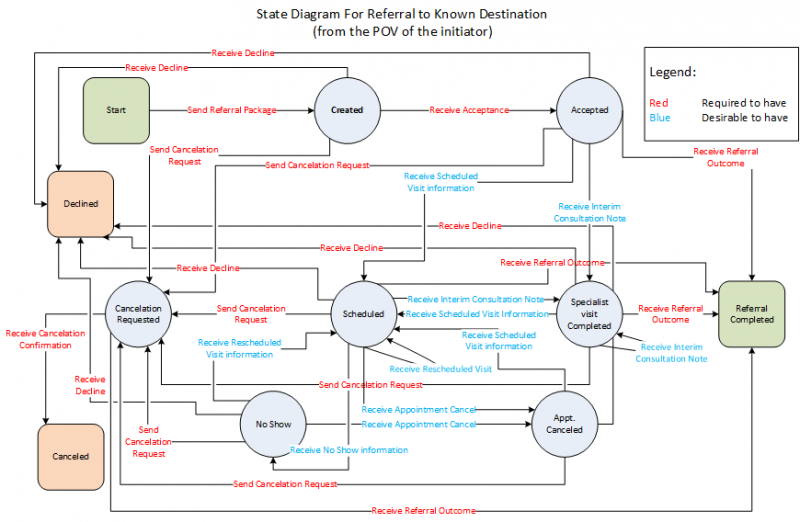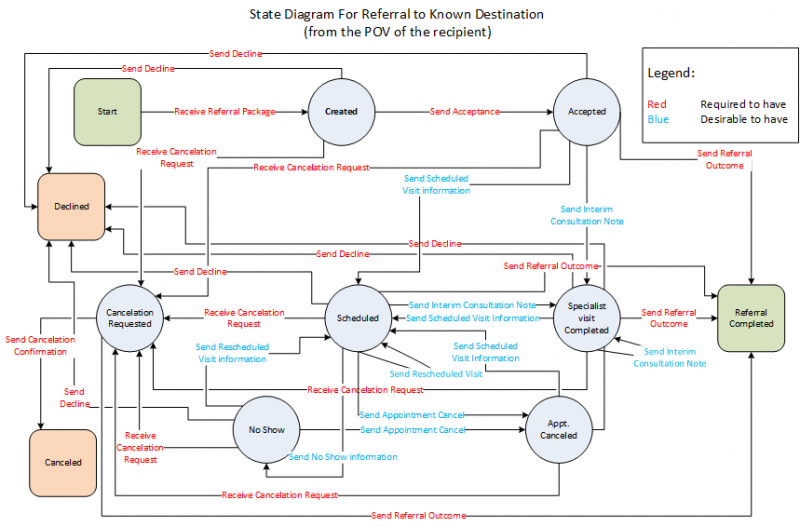Difference between revisions of "201809 VA Closed-Loop Referrals"
| (4 intermediate revisions by the same user not shown) | |||
| Line 1: | Line 1: | ||
[http://wiki.hl7.org/index.php?title=FHIR_Connectathon_19 Return to September 2018 FHIR Connectathon 19 home page] | [http://wiki.hl7.org/index.php?title=FHIR_Connectathon_19 Return to September 2018 FHIR Connectathon 19 home page] | ||
| − | + | [[Category:201809_FHIR_Connectathon_Track_Proposals|September 2018 Proposals]] | |
{| align="right" | {| align="right" | ||
| __TOC__ | | __TOC__ | ||
| Line 23: | Line 23: | ||
==Proposed Track Leads== | ==Proposed Track Leads== | ||
| − | + | :Matthew Self — VA | |
| + | ::E-mail: matthew.self2@va.gov | ||
==Expected participants== | ==Expected participants== | ||
| Line 56: | Line 57: | ||
A FHIR server (version 3.0) should support the following resources for closed-loop referral workflow: | A FHIR server (version 3.0) should support the following resources for closed-loop referral workflow: | ||
* [http://hl7.org/fhir/referralrequest.html ReferralRequest] | * [http://hl7.org/fhir/referralrequest.html ReferralRequest] | ||
| − | * [http://hl7.org/fhir/subscription.html Subscription] | + | * [http://hl7.org/fhir/subscription.html Subscription] – This enables a client to subscribe to notifications about updates to resources of interest. |
| + | ** For additional detail on use of FHIR Subscription services, see [[201701 Resource Subscription Track]] | ||
* Clinical data including, but not limited to: Patient, Observation, Procedure, MedicationRequest, and ProcedureRequest resources. | * Clinical data including, but not limited to: Patient, Observation, Procedure, MedicationRequest, and ProcedureRequest resources. | ||
Optional Resources: | Optional Resources: | ||
* [http://hl7.org/fhir/appointment.html Appointment], conforming to [http://www.fhir.org/guides/argonaut/scheduling/ Argonaut Scheduling IG] based on FHIR 3.0 | * [http://hl7.org/fhir/appointment.html Appointment], conforming to [http://www.fhir.org/guides/argonaut/scheduling/ Argonaut Scheduling IG] based on FHIR 3.0 | ||
| − | * Practitioner, PractitionerRole and Organization resources for provider directory. | + | * Practitioner, PractitionerRole and Organization resources for provider directory services. |
A FHIR server is available for testing with synthetic sample data that illustrates Veteran scenarios: | A FHIR server is available for testing with synthetic sample data that illustrates Veteran scenarios: | ||
Latest revision as of 23:48, 26 August 2018
Return to September 2018 FHIR Connectathon 19 home page
VA Closed-Loop Referrals
Submitting WG/Project/Implementer Group
- U.S. Veterans Health Administration
- Healthcare Services Platform Consortium (HSPC)
Justification
The U.S. Veterans Health Administration (VHA) seeks to achieve seamless care for Veterans across the continuum of care that increasingly includes healthcare services outside of VHA at community care providers. Estimates indicate that 30% of Veteran healthcare occurs outside of the VHA network and 60% of Veterans receive part of their care from community providers. Improving standards and interoperability for closed-loop referrals between VHA and community providers is an essential capability required to achieve seamless care. Although this requirement is certainly not limited to VHA and its community providers, the use cases and clinical data examples featured in this connectathon track will emphasize healthcare for Veterans.
The U.S. Office of the National Coordinator for Health Information Technology (ONC) organized the 360Exchange (360X) Project to accelerate interoperable health care data exchange in heterogeneous EHR technology environments. In particular, the 360X Project seeks to enable providers to exchange the following types of clinical information from within their EHR workflow, regardless of the EHR technology used:
- Referral requests containing relevant patient clinical information
- Result of referral containing relevant patient clinical information
Whereas the 360X Project emphasized C-CDA content and Direct transport infrastructure, this connectathon track focuses on fulfilling these requirements using FHIR resources, REST architecture for transport, and OAuth2 for security. The primary FHIR version for this track is STU3. However, extra credit will be awarded to participants that can demonstrate conversion between DSTU2 and STU3 to enable transport to/from referral participants that can support only FHIR DSTU2 endpoints.
This track will coordinate clinical scenarios and sample data with the Care Planning and Management track, which has a significant requirement for managing referrals and care coordination with specialty care providers.
Proposed Track Leads
- Matthew Self — VA
- E-mail: matthew.self2@va.gov
Expected participants
The following organizations have indicated an interest in participating in this track:
- Veterans Health Administration (VHA)
- Allscripts
- InterSystems
- Perspecta
- Your organization here!
Roles
Referral Request is defined as a request from one provider (referral initiator) to another provider (referral recipient). The request includes a description of the services the referral initiator wants for a patient (i.e., the reason for referral and the specific questions asked). For example, a primary care provider (PCP) may make a referral request to a cardiologist for diagnostic services. In practice, referrals usually cross care venues or practices (e.g., between acute and ambulatory or ambulatory specialists), whereas consults may imply within a venue (e.g., between two providers within an acute setting). Generally, with a referral both referral initiator and referral recipient remain responsible for overall patient care.
Referral Initiator
Within this connectathon track, the referral initiator role is from a primary care provider within the Veterans Health Administration (VHA).
- Create a new ReferralRequest and identify a provider organization and role for receipt.
- Link relevant clinical resources with this referral, as needed for context and supporting information.
- Utilize FHIR Subscription to notify referral recipient.
- Supports receiving and processing of FHIR Subscription resources, provides notifications for resources through the requested channel (if the channel is supported).
Referral Recipient
Within this connectathon track, the referral recipient is a "community provider" organization that is independent of the VHA network.
- Receive notification of ReferralRequest from VHA via FHIR Subscription. Query for the resource information if not provided in the notification payload.
- Notify VHA with Appointment for Veteran (optional for this track)
- Notify VHA when completed, along with link to access resulting clinical resources via SMART on FHIR application.
Community Care Coordinator
This role supports an advanced referral scenario where an independent organization fulfills a coordinator role to match referral requests with qualified providers, and tracks the referral request and response workflow on behalf of participating organizations.
FHIR Data Server
A FHIR server (version 3.0) should support the following resources for closed-loop referral workflow:
- ReferralRequest
- Subscription – This enables a client to subscribe to notifications about updates to resources of interest.
- For additional detail on use of FHIR Subscription services, see 201701 Resource Subscription Track
- Clinical data including, but not limited to: Patient, Observation, Procedure, MedicationRequest, and ProcedureRequest resources.
Optional Resources:
- Appointment, conforming to Argonaut Scheduling IG based on FHIR 3.0
- Practitioner, PractitionerRole and Organization resources for provider directory services.
A FHIR server is available for testing with synthetic sample data that illustrates Veteran scenarios:
- HSPC sandbox server (FHIR 3.0.1) at Endpoint TBD
Scenarios
The following two scenarios are included from the ONC 360X Referral Workflow as an illustration of referral state transitions. The first diagram shows state transitions from the point of view (POV) of the referral initiator, and the second diagram from the point of view of the referral recipient.

